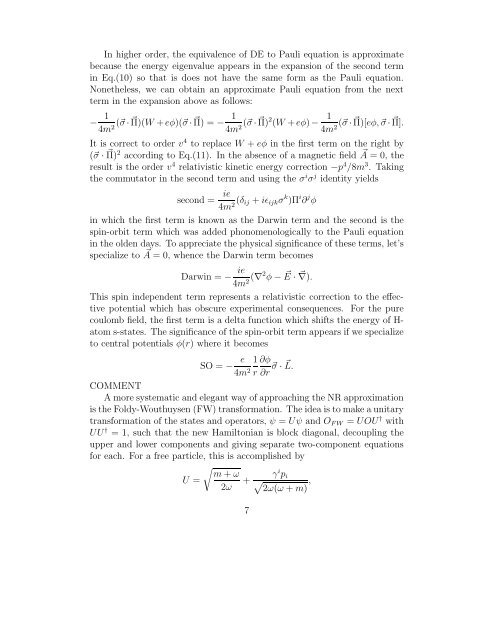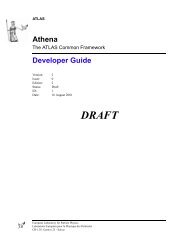0.1 Klein-Gordon Equation 0.2 Dirac Equation
0.1 Klein-Gordon Equation 0.2 Dirac Equation
0.1 Klein-Gordon Equation 0.2 Dirac Equation
Create successful ePaper yourself
Turn your PDF publications into a flip-book with our unique Google optimized e-Paper software.
In higher order, the equivalence of DE to Pauli equation is approximate<br />
because the energy eigenvalue appears in the expansion of the second term<br />
in Eq.(10) so that is does not have the same form as the Pauli equation.<br />
Nonetheless, we can obtain an approximate Pauli equation from the next<br />
term in the expansion above as follows:<br />
− 1<br />
4m 2 (⃗σ · ⃗Π)(W + eφ)(⃗σ · ⃗Π) = − 1<br />
4m 2 (⃗σ · ⃗Π) 2 (W + eφ) − 1<br />
4m 2 (⃗σ · ⃗Π)[eφ, ⃗σ · ⃗Π].<br />
It is correct to order v 4 to replace W + eφ in the first term on the right by<br />
(⃗σ · ⃗Π) 2 according to Eq.(11). In the absence of a magnetic field ⃗ A = 0, the<br />
result is the order v 4 relativistic kinetic energy correction −p 4 /8m 3 . Taking<br />
the commutator in the second term and using the σ i σ j identity yields<br />
second =<br />
ie<br />
4m (δ 2 ij + iɛ ijk σ k )Π i ∂ j φ<br />
in which the first term is known as the Darwin term and the second is the<br />
spin-orbit term which was added phonomenologically to the Pauli equation<br />
in the olden days. To appreciate the physical significance of these terms, let’s<br />
specialize to A ⃗ = 0, whence the Darwin term becomes<br />
Darwin = − ie<br />
4m 2 (∇2 φ − ⃗ E · ⃗∇).<br />
This spin independent term represents a relativistic correction to the effective<br />
potential which has obscure experimental consequences. For the pure<br />
coulomb field, the first term is a delta function which shifts the energy of H-<br />
atom s-states. The significance of the spin-orbit term appears if we specialize<br />
to central potentials φ(r) where it becomes<br />
SO = −<br />
e 1 ∂φ<br />
⃗σ · ⃗L.<br />
4m 2 r ∂r<br />
COMMENT<br />
A more systematic and elegant way of approaching the NR approximation<br />
is the Foldy-Wouthuysen (FW) transformation. The idea is to make a unitary<br />
transformation of the states and operators, ψ = Uψ and O F W = UOU † with<br />
UU † = 1, such that the new Hamiltonian is block diagonal, decoupling the<br />
upper and lower components and giving separate two-component equations<br />
for each. For a free particle, this is accomplished by<br />
√<br />
m + ω<br />
U =<br />
2ω + γ i p<br />
√ i<br />
,<br />
2ω(ω + m)<br />
7
















